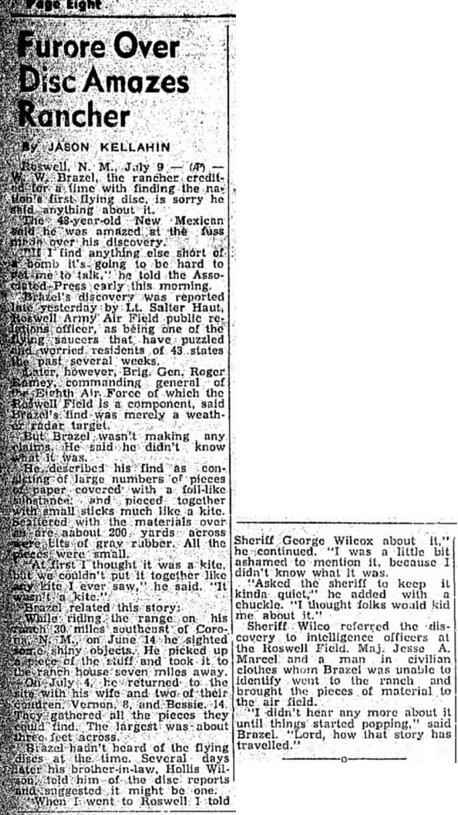
The article below was published in the newspaper Hope Star, Arkansas, USA, page 8, on July 11, 1947.

|
Roswell, N. M., Jul 9 -- (AP) -- W. W. Brazel, the rancher credited for a time with finding the nation's first flying disc, is sorry he said anything about it.
The 48-year-old New Mexican said he was amazed at the fuss made over his discovery.
"If I find anything else short of a bomb it's going to be hard to get me to talk," he told the Associated Press early this morning.
Brazel's discovery was reported late yesterday by Lt. Salter [sic, Walter] Haut, Roswell Army Air Field public relations officer, as being one of the flying saucers that have puzzled and worried residents of 43 states in the past several weeks.
Later, however, Brig. Gen. Roger Ramey, commanding general of the Eight Air Force of which Roswell Field is a component, said Brazel's find was merely a weather radar target.
But Brazel wasn't making any claims. He sais he didn't know what it was.
He described his find as consisting of large numbers of pieces of paper covered with a foil-like substance, and pieced together with small sticks much like a kite. Scattered with the materials over an area about 200 yards across were bits of gray rubber. All the pieces were small.
"At first I thought it was a kite. But we couldn't put it together like any kite I ever saw," he said. "It wasn't a kite."
Brazel related this story:
While riding the range on his ranch 30 miles southeast of Corona, N. M., on June 14, he sighted some shiny objects. He picked up a piece of the stuff and took it to the ranch house seven miles away.
On July 4, he returned on the site with his wife and two of their children, Vernon, 8, and Bessie, 14. They gathered all the pieces they could find. The largest was about three feet across.
Brazel hadn't heard of the flying discs at the time. Several days later, his brother-in-law, Hollis Wilson, told him of the disc reports and suggested it might be one.
"When I went to Roswell I told Sheriff George Wilcox about it," he continued. "I was a little bit ashamed to mention it, because I didn't know what it was.
"Asked the sheriff to keep it kinda quiet," he added with a chuckle. "I thought folks would kid me about it."
Sheriff Wilcox referred the discovery to intelligence officers at the Roswell Field. Maj. Jesse A. Marcel and a man in civilian clothes whom Brazel was unable to identify went to the ranch and brought the pieces of material to the air field.
"I didn't hear any more about it until the things started popping," said Brazel. "Lord, how that story has traveled."